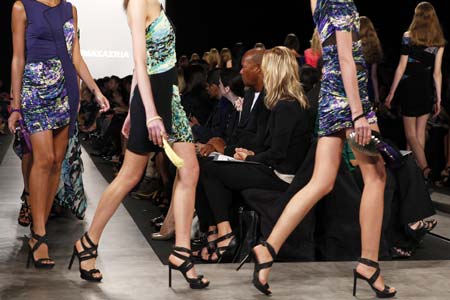NY Fashion Week adds gloss to recession
 |
|
Models present creations at the BCBG Max Azria Spring 2010 collection during New York Fashion Week Sept 10, 2009. [Xinhua/Reuters] |
With all its glitz and glamor, Mercedes-Benz Fashion Week (MBFW) kicked off on Thursday under theiconic tents at Bryant Park. Celebrities, fashionists and industry moguls swarmed into central Manhattan to take a first glimpse at designers' Spring 2010 collection.
But as the rest of New York City still trembles from the economic recession, the fashion industry appears to have put on its best face on and come out fighting, or strutting.
"This is going to be a terrific week and I think that we're all looking forward to an energized industry that's starting to feel a little bit better and more confident about the economy," Senior Vice-President of MBFW Fern Mallis told Xinhua in an exclusive interview.
While each designer featured at this season's Fashion Week had the chance to cut back on production costs, no one had.
"This is part of their marketing budget (and) an important part of their business," Mallis said. "Designers at the level we're talking about all need to put on a show to let everybody know what their vision is."
"It's a way people get to know and talk about what they're doing (and) it keeps them front and center," she said.
How times have already changed.
During MBFW in February, just several months after the economic recession hit, well-known designers like Betsey Johnson and Vera Wang scaled back their shows by displaying their fall 2009 collections on mannequins rather than on live models.
Producing a show at Bryant Park during MBFW can run anywhere from 26,000 U.S. dollars up to 50,000 dollars depending on the size, said Mallis.
"They can spend a fortune on top of the line super model, they can spend a little less money on developing new, young fabulous faces," she said. "They can put in huge production value or they can just send those clothes out simply. It's up to them and their own budgets."
Since the economic recession hit, the fashion industry has been grappling with how to accommodate for a 26-year high unemployment rate.
According to the American Apparel and Footwear Association, the average U.S. consumer purchased 64 articles of clothing and seven pairs of shoes in 2008, compared to 67 articles of clothing and eight pairs of shoes in 2007.
Mallis acknowledged that for the most part the fashion industry-- advertisers, designers, and retailers -- had to narrow down, focus, and spend their money wisely so as not to pass the buck off to consumers.
"The retailers have made adjustments in cutting back on orders and being a little bit more focused and I think the designers have been a little bit more focused also," she said. "They're not going to be sending out anything that is gratuitous and just extra for the sake of it."
 0 Comments
0 Comments






